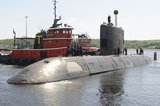Panic over shipping routes through tense Middle East subside
As the embers of US-Iranian struggle for influence in the Middle East return to a dull glow following a week of tensions, the heightened threat of attacks on shipping in regional waters has ebbed.
The initial consensus was that Iran could look to continue its, and associated proxy, efforts in the Red Sea, Bab al Mandeb, Strait of Hormuz and the Gulf to attack commercial or military shipping in transit through or operating in the region.
However, Iranian officials were keen to be seen to take the diplomatic high ground in moving to reassure ship operators that trade would continue
Already have an account? Log in
Want to keep reading this article?
More from Naval Warfare
-
![Is the US Navy’s Golden Fleet initiative achievable?]()
Is the US Navy’s Golden Fleet initiative achievable?
The effort to provide the US Navy with Trump-class battleships might face financial, production and doctrinal obstacles.
-
![How will SAFE shape naval procurement for Canada and its highest-receiving members?]()
How will SAFE shape naval procurement for Canada and its highest-receiving members?
Canada’s inclusion on the EU’s Security Action for Europe initiative is set to enhance the country’s defence procurement strategy with important implications for some of its naval programmes, while Poland and Romania have also secured significant SAFE funding.
-
![Thales wins DE&S contract for portable autonomous command centres]()
Thales wins DE&S contract for portable autonomous command centres
The agreement to provide portable autonomous command centres to the UK Royal Navy will enhance the service’s Mine Counter Measure operations and further integrate autonomous and uncrewed systems into its fleet.
-
![Maritime defence in the Mediterranean faces challenges from vulnerable land power]()
Maritime defence in the Mediterranean faces challenges from vulnerable land power
As an indispensable energy crossroads, the Mediterranean is at serious risk from grey zone disruption. As navies increasingly employ AI data centres, what happens when cutting-edge defence technologies rely on the very infrastructure most susceptible to hybrid tactics?























